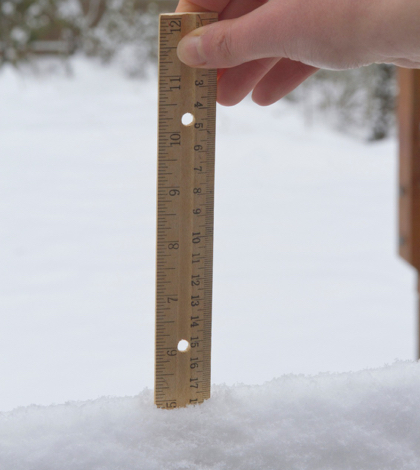Oh, what a difference a month can make! Thursday’s manual snow survey at Phillips Station in the Sierra Nevada mountains recorded 28.1 inches of snow water equivalence (SWE) over the mere six inches found there during the January 3 survey. In the words of Frank Gehrke, chief of the California Cooperative Snow Surveys Program, “January really built a pretty amazing snowpack.”
Snow water equivalence is, in theory, the amount of water that would result if the entire snowpack melted instantaneously. The SWE measurement is more important in assessing the status of the snowpack since the melted snowpack supplies about 30 percent of California’s water needs when it melts in the spring and early summer.
Despite the publicity of the manual measurement at Phillips Station are the electronic readings the Department of Water Resources (DWR) takes its 101 stations scattered throughout the Sierra Nevada. Statewide, the snowpack holds 31 inches of water equivalent, or 173 percent of the February 2 average of 18.1 inches. Before a series of January storms, the snow water equivalent of the statewide snowpack on January 1 was 6.5 inches, the equivalent of just 64 percent of the New Year’s Day average.
The newest measurements indicate the water content of the northern Sierra snowpack is 26 inches, 144 percent of the historical average for the date. The central Sierra is measuring 32 inches (173 percent of average) and the southern Sierra is recording 32 inches (200 percent of average).
Other measurements indicative of the state’s recent precipitation are equally as robust. Thanks to January’s deluge from atmospheric river storms and rainfall from lesser storms, all three regions DWR continuously monitors for their rainfall had recorded more by January 23 than their annual averages for the entire water year. (The water year runs from October 1 to September 30.) The SWE equivalents for DWR’s regions for Feb. 2, 2017 were:
- Northern Sierra/Trinity: SWE-26.1 inches, 94 percent of the April 1 average and 144 percent of normal for the date.
- Central Sierra: SWE-32.4 inches, 111 percent of the April 1 average and 173 percent of normal for the date.
- Southern Sierra: SWE-32.5 inches, 120 percent of the April 1 average and 200 percent of normal for the date.
Likewise, almost all of California’s reservoirs are also posting impressive early season water measurements. Shasta Lake, California’s largest surface reservoir, is holding 114 percent of its historical average for Feb. 2. One year ago, Shasta’s storage was just 78 percent of its average for the date. Similarly, Lake Oroville, the State Water Project’s largest reservoir, is holding 121 percent of its historical average compared to just 68 percent one year ago today.
But Californians are still strongly urged to conserve water as parts of the state are still classified in varying stages of drought. State Climatologist Mike Anderson acknowledged how varied California’s weather can be by saying, “In the last 10 water years, eight have been dry, one wet, one average. Hopefully this year will end up being wet, but we cannot say whether it will be one wet year in another string of dry ones.”
Gehrke summed up the current status of the Sierra Nevada’s snowpack and reported that “we’ve got a very good snowpack, a very robust snowpack on the ground right now.”
 California Water News Daily Your Source For Water News in California
California Water News Daily Your Source For Water News in California


